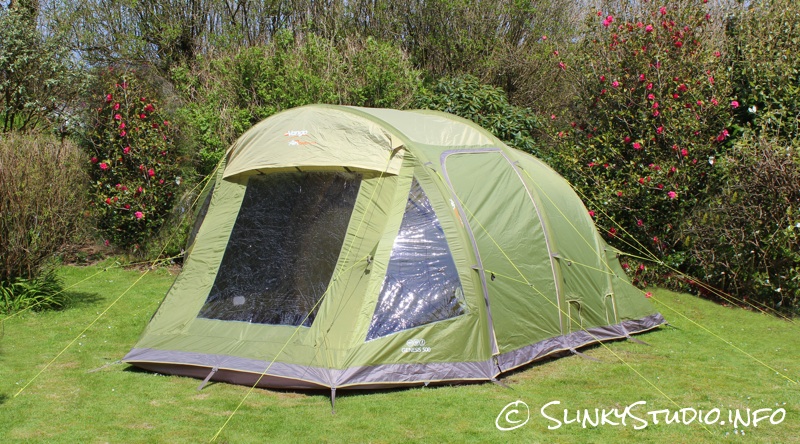Vango Genesis 500 Tent Review
We're slightly fascinated by tents using inflatable designs. Vango have a varied lineup of different sized tents using their AirBeam technology and we've got one of their biggest offerings here. It's known as the Vango Genesis 500 tent and it couldn't have shown up at our studio at a better time. The budding of summer is here, so what better way can we enjoy great weather and the outdoors in harmony, than by going camping.
Pitching
We're not new to inflatable beam/frame designs, we've previously reviewed two tents that featured such designs last summer. The marvellously simple Vango Velocity 400 Tent and the highly innovative spectacle that is the Heimplanet Cave Tent. But the Vango Genesis 500 Tent is the largest tent we've tested using inflatable technology, so it was particularly interesting because of its scale. Smaller versions of the Genesis tent are also available, these are appropriately named the Genesis 300 (sleeps three) and Genesis 400 (sleeps four).
The steps for pitching this tent are as follows: Lay tent, peg the corners, locate the AirBeam valves on the exterior of the tent, which are also accessible from inside the tent when the tent is erected, and pump each AirBeam to within the PSI threshold stated on the supplied double action pumps gauge. Each of the three independent AirBeams takes around thirty seconds to inflate. At this point the tent's structure will be present and we usually reposition the corner pegs slightly and peg the rest of the tent and luminous guy ropes down. Both round steel pegs and v-pegs are supplied and both are very strong, but we'd have liked to have seen all pegs made from alloy so they didn't rust. From getting the tent out of the bag to having it fully pitched took just over six minutes (we weren't rushing), the same time Vango claim.
This is speedy, and a dream scenario when arriving at a campsite or patch of land where it's pouring with rain and you just want to hop into shelter! When it came time to take down the tent, we discovered that this actually takes longer than pitching it, with the main time consuming challenge being getting the tent to squeeze back into its bag, which at this stage always seems as if someone has switched the original bag for a miniature replica. Once in its bag the tent can easily be transported in the boot of a car, but does weigh 16kg, so trekking is off the agenda.
Design
Like most of the 2014 AirBeam tents, Vango are using a dark olive-like shade of green. It looks smart on the Genesis, but if we had to nit pick we'd have preferred the 2013 lighter shade of green coupled with black colour scheme to have remained. The Genesis 500 could quite easily be mistaken as an awning at first glance; at its peak it measures 495cm in length, 210cm in height and 320cm in width. The tent's tunnel shape has many aerodynamic design incorporations and is taller at the front porch area, diminishing narrowly as the design tails off.
Porch
The front porch area of the Vango Genesis 500 measures 265cm x 320cm. This is a generous floor space with a lightweight 300 denier Oxford ground sheet sewn to the flysheet via an external storm skirt which the entire tent features at its base. The porch also measures 205cm in height, so most average height adults should have no problem being able to stand up in this area. BBQs, cookers, bags, seats, tables, cool boxes, etc can all be stored within the front porch. But if you're travelling light, you could sleep an extra four-five people in this area too, you just don't want to touch the sides of the porch as there is no internal sheet under the polyester flysheet.
Like the rest of the tent, the porch area is flame retardant, which is reassuring when storing things like cookers and operating lamps in the tent with you. We enjoyed the flexibility of being able to adjust the amount of light and heat let into the tent via the functionality of the porch. We always welcome windows in family tent design and this tent would have been a bit confined without some. So the three PVC windows running along the front of the porch really open the area up to be a friendly recreational residence if desired, and with the doors fully unzipped, it's the next best thing to a canopy. The two main opposing door entrances with easy to undo Duraflex buckles and zip pullers are quick to locate to enter and exit the tent. Optional mosquito meshes can also be zipped, and as well as keeping wildlife out, they also enhance ventilation of the tent during warm days and nights.
Sleeping Area
Often we find the sleeping areas in tents intimate when at full rated berth capacity. However, five people sleeping in the Vango Genesis 500 300cm x 210cm sleeping area will actually have a comfortable and roomy experience, and four people would have plenty of distance between them to stretch their arms freely in the morning. There are pockets for storing immediate possessions like torches, books, smartphones and also decent helpings of space for people to move around and travel into the front awning area with ease, aided by the two zipped doors with mosquito meshes for improved ventilation if required. The sleeping area is made from breathable polyester, which features 'lights out'. This basically means the fabric is darker and reduces the degree of light let into the area in early mornings, so you don't get disturbed by the sun and wake up.
Versatility
So over the course of 30 days we left the tent outside to stand a range of different weather conditions. Initially we were a tad sceptical and fearful about how such a large tent with essentially inflatable tubes would hold up to viscous winds, and ironically the weather it had to stave off was an amalgam of heavy downpours of rain and harsh gusty winds. It didn't let a drop of water through its highly rated water resistance 5000mm water column provided from the ProTex 70D polyester flysheet. The heavy wind of this period was reported to be around 40-60mph and didn't manage to cause any damage or move the tent. The high AirBeams showed off how fantastic they are at holding a solid structure and making sure campers can get a good sleep inside the tent with little disturbance from the outside battering of wind.
We've reviewed pole based tents that are similar in style and also share the height, such as the Skandika Vastervick and Drammen 4, but they just were't as stable as the Genesis 500 tent is with its AirBeams. Assisting the AirBeams to create a tighter structure in weather such as this, is an internal Tension Band System (TBS II); two of these are present along the ceiling in the porch area where the tightness can be immediately adjusted when necessary. For the last fifteen days pitched the Vango was given a break and had consecutive bright blue skies and baking hot temperatures, and we're pleased to report that the exterior materials didn't fade. Being able to test the Genesis 500 in completely different weather environments allowed us to really evaluative whether it's a good tent to use in different seasons and not just weekends away in the summer. Which we think it is, as it confidently shelters and traps heat as well as having brilliant ventilation options.
Overall
The Vango Genesis 500 is a well designed tent that offers space hungry families and groups of friends an attractive and highly convenient method of straight to the point camping.















